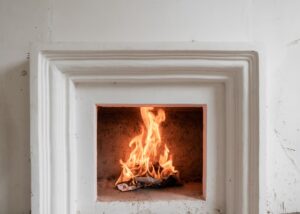Fireplace Leaving Smoke Residue in House? Here’s What You Should Do
 Most families, including yours, light fireplaces during the winter season to keep the house warm and cozy; however, you see smoke filling up the room once you light it. You should never notice smoke in your home after starting a fire in your fireplace.
Most families, including yours, light fireplaces during the winter season to keep the house warm and cozy; however, you see smoke filling up the room once you light it. You should never notice smoke in your home after starting a fire in your fireplace.
When your fireplace and chimney vent properly, fire byproducts (such as smoke, vapor, and unburned wood) are pushed up the flue and out of the house, while the outside air is drawn into the flue to keep the flames alive. This process is called “draft.”
However, all the contents filling up your living room could severely damage your belongings and harm your family members. Smoke contains toxins and microscopic particles that give rise to many health risks, such as breathing difficulties.
Many professional restoration companies, such as 911 Restoration, use advanced cleaning methods to restore your home after smoke damage and make it a safe place for your family to live in again.
Why Your Fireplace Might Be Smoking Up the House
A fireplace that has been leaving smoke and other components into the room is a sign of a weak chimney and fireplace draft system that is causing all the byproducts of smoke to fill up the room instead of leaving the house through the chimney.
Below are a few reasons why this could happen and how to fix this problem so you can spend your cold winters in front of the fireplace.
Temperature Difference
Most of the time, the reason is the difference between indoor and outdoor temperatures. The greater the temperature difference, the stronger the draft system; the lower the difference, the weaker the draft system.
To explain this better, when it’s cold outside and warm inside, the smoke and all the byproducts produced would raise the chimney and leave. However, if it is warm inside and the temperature outside is similar, the smoke and byproducts will most likely float in the firebox and enter the room rather than leave the chimney.
Likewise, proper drafting will not occur if the flue is cold because hot air will float in the cold flue rather than rising to the top of the chimney. That is why it is important to check the temperature difference before starting a fire. There should be a difference of at least 20 degrees.
Water Is Seeping into the Flue
Rain and snow can easily seep in through the chimney when it is uncovered. Its coldness will lower the air temperature in the flue and firebox and weaken the draft, causing smoke to puff back.
To avoid this problem, have a professional install a chimney cap. A cap will keep the water out and prevent indoor smoke.
Flue Is Blocked
Chimney flue can become easily blocked by leaf debris, animal nests, or the buildup of creosote. These obstructions can hinder the functioning of the chimney by preventing the smoke from the firebox from leaving to the outdoors. These blockades would cause the smoke to travel back indoors.
In more severe situations, the creosote buildup can catch fire and cause structural damage to the property. That is why it is important to remove the hindrances with the help of professional services.
Negative Air Pressure
For a chimney draft to work effectively, it is crucial to have a neutral air pressure; this means the outside air enters the home at the same rate as inside air exits it, so indoor and outdoor air pressure is the same. This pressure allows fire byproducts to exit the flue as the outside air enters it.
However, in a house with negative air pressure, more air enters the home than exits it. This pushes down smoke in the flue to enter your home. To stop this from happening, the next time you light your fireplace, make sure you also open a nearby window or door to neutralize the air pressure.
You could also ask a professional to install an air supply vent at the back of the firebox to regulate air pressure.
Follow The Steps Below for Smoke-Free Fireplace Operation.
The next time you light up the fireplace, follow these fireplace operation and chimney maintenance tips:
Use Safe Fuel, Kindling, And Tinder.
Only use well-seasoned hardwood as fuel or dried twigs or branches as kindling, and as tinder, use tore old newspaper or pine cones. Unseasoned firewood or cardboard can produce a large amount of smoke that your chimney cannot efficiently evacuate.
Employ The Top-Down Burn Method
To minimize smoke, place large blocks of firewood vertically, and then on top of it, add horizontal layers of kindling and then tinder.
Remove Ashes from The Firebox After Use
After blowing out the fire, when the firebox is completely cool, with the help of a shovel, remove the remaining ashes into a metal container. Ashes in the firebox from the last burn can cause the fireplace to emit more smoke and byproducts.
When to Call 911Restoration
If your fireplace is causing smoke damage, then it is time to call for help. 911 Restoration has experienced smoke damage specialists in cleaning and repairing smoke-damaged walls, flooring, upholstery, and furniture. Call (205) 440-3745 to speak with the experts about the soot removal process and inspection. Our priority is customer satisfaction, and our services are available 24/7 for your ease.




Leave a Reply